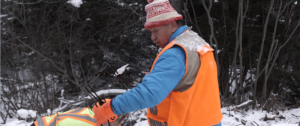Nokiiwin Tribal Council release authentic cultural lessons for children to learn at home during COVID-19 pandemic

By Rick Garrick
THUNDER BAY — The Nokiiwin Tribal Council plans to post a series of 13 Telling Our Stories videos and activity sheets for families to use during the coronavirus disease 2019 (COVID-19) pandemic.
“These were actually created in 2018 and 2019 and the idea then was to give schools in our area local [Indigenous] content,” says Scott Baker, education manager with Nokiiwin. “Those have been available to the schools since they were made, but because all the students are home now we decided we would repurpose them a little bit and put them out for public use.”
Baker says the plan is to post one video and activity sheet per week — the Stan Sabourin: Trapping video and activity sheet was posted on Apr. 8 and the James (Jim) Mishquart: The Powwow Trail video and activity sheet was posted on Apr. 17. The videos and activity sheets are posted on the Nokiiwin website and the Nokiiwin Facebook page.
“We have some about beadwork, some about growing up in those communities along the train tracks, some about going to residential school,” Baker says. “Along with the videos, there is a curriculum for teachers to use with their students so I’ve been rewriting that so parents can use it. Some of the school activities I can’t put in because they rely on being in a school.”
Sabourin, a certified trapping instructor and former teacher, says the Telling Our Stories project was a “wonderful” experience, noting that his grandchildren saw both the trapping and film industries during the filming process led by Fort William filmmaker Erin Collins.
“To me, [trapping] is part of our culture, it’s part of our way of life,” Sabourin says. “I grew up this way, I learned from my grandparents, from my parents, and passing it on to people who want to learn— it’s lifelong learning. It creates family togetherness — the family gets to participate in all aspects of trapping by preparing the traps, preparing the pelts, preparing the sites.”
Sabourin says the students who participated in the trapping video had a “lot of fun” during the filming process.
“They helped each other, and by helping each other it created a team atmosphere,” Sabourin says.
Collins says it was “really cool” to do the Stan Sabourin: Trapping video because she had not been out trapping before.
“Stan was a great teacher and he did a great job,” Collins says. “It was great for me to learn [about trapping] and it ended up being probably one of my favourite videos.”
Collins says the people she highlighted in the 13 videos each brought a different value and a different lesson to the project.
“Jimmy (Mishquart) was one of the first people we interviewed,” Collins says. “It’s something a lot of people can relate to— going to the Pow Wow for their whole life.”
Collins says it was important for her to do the videos because she never learned about what the participants were sharing while she was in school.
“In school, I didn’t know of any of these things or any of these people or stories from our community and so close to home,” Collins says. “It’s like, why not? I love helping to teach people and if I can use what I do as a career and as a passion to educate youth and people on our culture, what else can you ask for?”


